By Rohan Mukerjee, Sudipta Satpati, Fatik Kumar Hembram, Jiban Hansda, Binod Sabar, Bishnu Sabar and Bharati Sabar
—-
History of the Kheria Sabars
In West Bengal, the Kheria Sabar community is said to have descended from the forest-dwelling Hill Kharia people of the Central Indian belt. They reside in tolas or paras (small hamlets) within the forest swathes of south-eastern Purulia district and in the adjacent East and West Singhbhum districts of Jharkhand. Some also reside in Western Bankura bordering Purulia, and in north-western Medinipur, where they migrated from Chotanagpur. Thought to be among the earliest inhabitants of Purulia, the Kheria Sabar were nomads who relied on the hunting of birds and wild animals, fishing, collection of honey, fruits, flowers, tubers and other wild food from the forests.
The British era saw violence in the form of destruction of their forest homes and resources. The subsequent nationalization of remaining forests after Independence allowed for continued degradation and alienation of the community from their own forests, leading to further marginalisation. Implementation of the Forest Rights Act, 2006 (FRA) has been far from satisfactory, with only a few Individual Forest Rights claims achieving success, and no significant progress on claims for Community Forest Rights.
The Criminal Tribes Act passed by the British in 1871 which classified 136 communities as ‘criminal’ was repealed in 1952, with tribes being ‘denotified’. Ironically, instead of freeing them from the stigma instilled by the British, the term ‘denotified’ remains derogatory even more than half a century later. These communities, which include the Kheria Sabar, are still being persecuted as criminals, and falling victims to police atrocities and mob frenzy.
Since the 1960s, Paschim Banga Kheria Sabar Kalyan Samiti (PBKSKS) a community based organisation based in Rajnowagarh in Purulia has been working with the Kheria Sabar people, rallying against their eviction from forestlands and starting conversations on the social stigma associated with them. They focus on ecological and cultural needs of the space, with efforts to revive traditional horticulture, conserve soil and water, and afforestation. Their work also attempts to improve the community’s traditional and sustainable practices related to ayurveda. Health and vocational training camps are held regularly too.
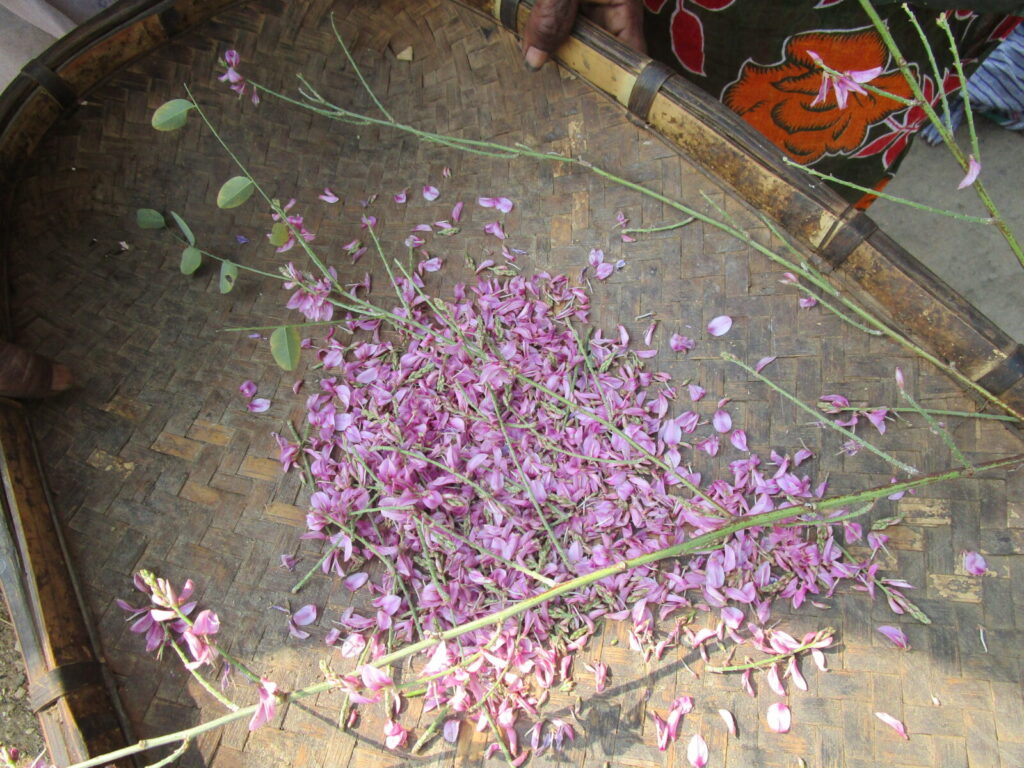 Image: Jihur Phun
Image: Jihur Phun
A partnership for wild food nurseries in Central India
Keystone Foundation has been working alongside PBKSKS since 2020 under our Using Diversity Network project focusingon research, documentation and revival of traditional and wild food systems and livelihoods, alongside support for improving implementation of the FRA in 30 villages. Our surveys revealed that despite an unimaginably violent history that has led to extremely degraded forests in comparison to their past glory, the Kheria Sabar people still collect and cherish a diversity of wild foods – over 100 native plant and fungi species. Community fellow Binod Sabar highlights some popular wild foods among the Sabar people –
- Kudair saak Kudair is a wild green leafy vegetable paired with corn gruel. It contains important minerals that cleanse the stomach when consumed in modest quantities. Eaten during the day, its name in the Santali language is Singhara (literally translating to day-vegetable).
- Kend or Tendu (Diospyros melanoxylon) Kend is a favourite fruit among children. It is cooked in local delicacies when unripe and eaten as is when ripe. The leaves are used to make Beedi, making the tree vulnerable to exploitation. In many areas there has been a steep decline, with only a few mature trees left.
- Jihur Fun or Jirhul Phul (Lagerstroemia speciosa) This striking flower of a deciduous tree, found especially in dense forest tracts, is collected, cleaned, and cooked with pulses or potatoes.
- Baola Audh (Dioscorea sp.) A common wild tuber, it grows in forests and around agricultural fields. Thinly sliced, it is soaked in water for a day and boiled twice and seasoned lightly with salt. This tuber is popular during puja festivals.
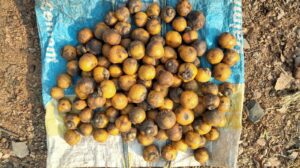
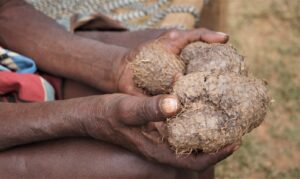 Images: Kend or Tendu and Baola Audh
Images: Kend or Tendu and Baola Audh
This immense diversity of wild foods, and associated culture, traditional practices, and the identity of the Kheria Sabar community are threatened by declining plant populations and diversity of the region’s forests. Many forest areas have been noted to completely stop bearing wild foods. The PBKSKS team has been facilitating the setting up of community nurseries. Since the Kheria Sabar community had never grown nurseries before, they were quite apprehensive. PBKSKS team members Fatik Hembram, Sudipta Satpati (agriculture consultant), along with Binod Sabar and Jiban Hansda (community fellows) have been managing the nurseries and learning on the job. Fatik took the lead and established one of the first nurseries in Shalidih village in April 2021. Two active nurseries have been established in Shalidih and Jarra, with another in Migrichami is in process of being revived.
Slowly, the community began to develop the skills needed and are taking ownership of the nurseries. They helped prepare a list of species whose seeds were to be collected, along with information on seasonality. Priority was given to commercially important species that would enhance their livelihoods, and contribute to health and nutritional security. Next, Binod and Jiban visited forest areas like Amjhorna and Burijhor to collect seeds. Kend (Diospyros melanoxylon) and Piyal were the first seeds acquired.
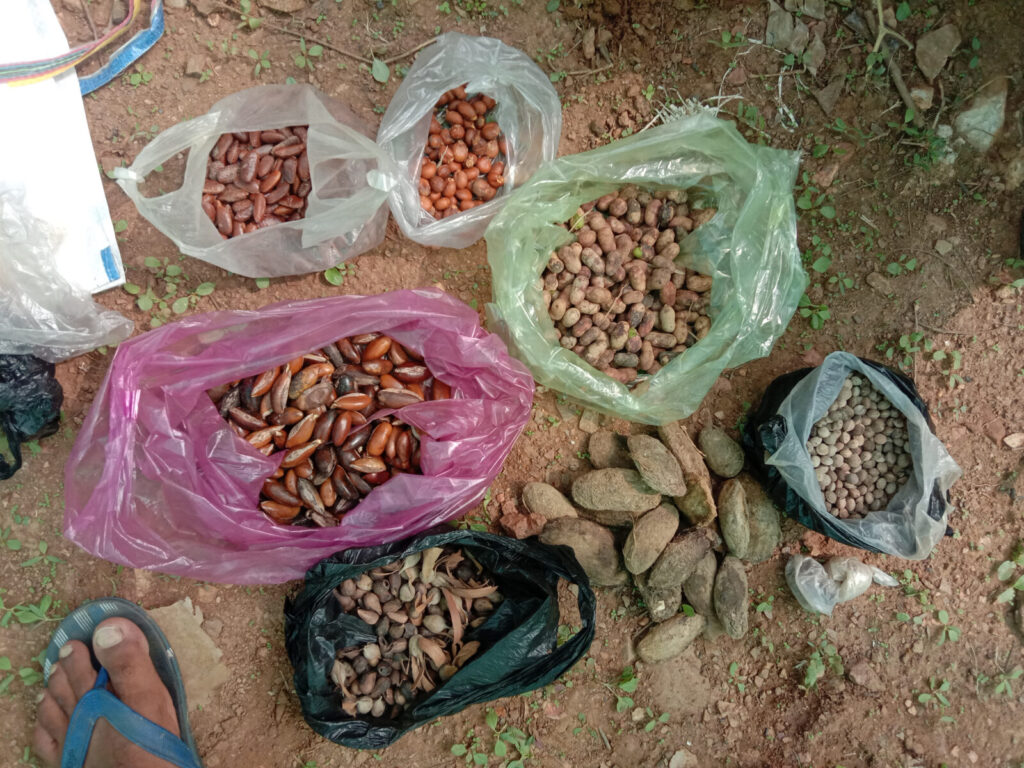 A diversity of seeds collected for the native nursery
A diversity of seeds collected for the native nursery
Soon, the fellows had a diverse seed bank: kurchi (Holarrhena pubescence), chihar, baola, haritaki (Terminalia chebula), kudol (Bauhinia variegata), sajna (Moringa oleifera), bhela (Semecarpus anacardium), amaltash (Cassia fistula), mechara, behra (Terminallia bellirica), mahua (Madhuca longifolia), gurmon and krishnachura (Delonix regia). Villagers who helped with seed collection included Ajit, Ganesh, Ranjit, Poresh, Shabi, Golapi and Ravi Sabar. Aamloki or amla (Emblica officinalis) saplings were purchased from a local nursery and distributed as they have become very rare in the area, with most of the older trees no longer bearing fruit.
Nursery preparation work commenced towards the end of April 2021 in Mirgichami and Shalidih villages. The shed was built using locally sourced sustainable material like bamboo, rope, nails, branches of the sal tree and discarded tyres. “Bamboo and paddy straw were used for the roof to protect saplings from the harsh summer sun,” explains Sudipta. With the shed ready, Kheria Sabar youth and elders began to lay the beds and sow seeds.
Kudol, an uncultivated green leafy vegetable; sajna and papaya saplings were ready for planting in July. However, saplings of other species were still too small: mahua, kend, pial, behra and gurmon. “We decided that kudol, sajna and papaya would be distributed this year, while the rest would need to be nurtured for another year,” says Sudipta. In July, Keystone and PBKSKS team distributed around 200 saplings across 10 villages for planting in community members’ forest areas.
Challenges faced and solutions surfaced
The first year was a learning experience for the PBKSKS team and the community. The successful collection of seeds, growth of saplings and distribution was an encouraging boost for everyone involved. However, the journey was not without challenges.
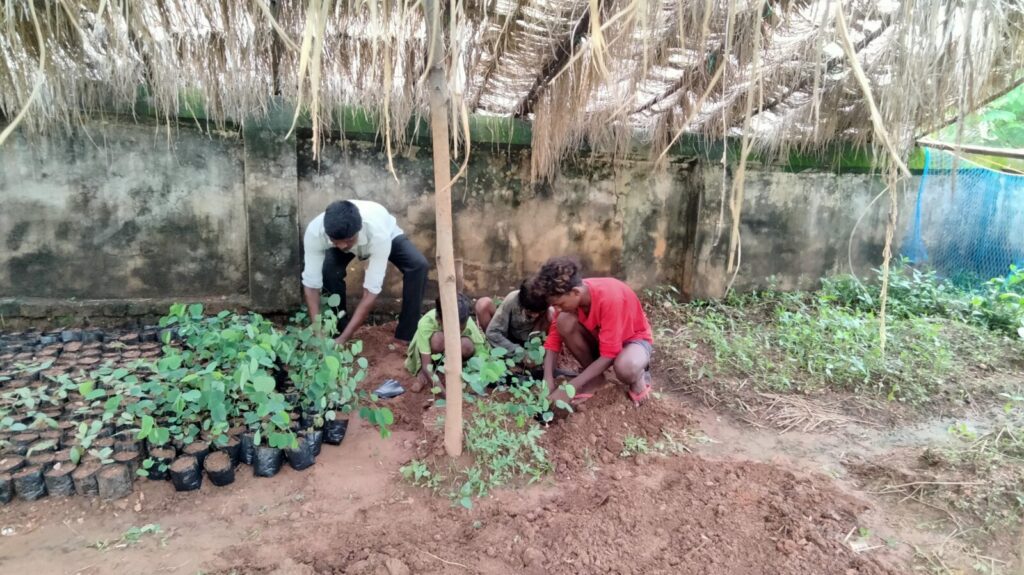 Image: Nursery in Mirgichami
Image: Nursery in Mirgichami
The bamboo frame of the nursery sheds did not last survive the heavy downpours during the monsoon of 2021, and along with the straw roof, was close to collapsing by the end of the year. In 2022, a sturdier structure was built using cement pillars and iron pipes in Shalidih. During heavy rains, a polythene is used. Unfortunately, acute water scarcity in Mirgichami, aggravated by an unseasonably dry monsoon in 2022 left no choice but to close the nursery here and move saplings to the one in Shalidih. On a positive note, a solar-powered borewell was installed by the government water, and plans are underway to reopen the Mirgichami nursery soon!
Discussions with community members provided more insight on challenges. Chottu Lal from Mirgichami pointed out, “Everyone in the village gets busy with their own work – we have no one person responsible for looking after the nursery. It becomes difficult to manage and water scarcity makes matters even harder. It might be a good idea to have one person with primary responsibility with other villagers playing a supporting role.”
The survival of transplanted saplings is also a gamble, with many saplings being ravaged by livestock. Gobindo from Mirgichami says that he had lost his kudol saplings to goats and one jamun sapling to rats – however, he proudly showed us that the jamun sapling in his homestead plot was doing very well.
Kuchia village, where saplings are closely managed by families, reported a high survival rate of saplings. Many villagers like chose to build makeshift fencing that helped ensure survival.
The way forward: future of the wild food nurseries
Despite challenges, the efforts of the PBKSKS team and villagers bore fruit, with hundreds of saplings making it through. Many are planning another round of seed collection in the summer months. PBKSKS and Keystone are identifying villagers who are willing to join the team in caring for saplings in the nurseries and after transplantation through fencing and other means.
Saplings in the Shalidih nursery continued to prosper with species like jamun, kusum (Schleichera oleosa) and behchi (a sweet fruit that is rich in iron and entire fruit is eaten along with the seeds). Behchi trees are rapidly disappearing, making it difficult to source seeds.
Motivated by the success of the first nurseries, another was established under the care of community fellow Bharti Sabar in Jarra village. Since forest tracts are fast losing floral diversity in Jarra, most seeds were sourced from the Sabar villages in Bankura district, West Bengal. Despite such challenges, along with the ever-persistent water scarcity, Bharati and her team have successfully raised over 700 saplings till date! These will be ready for distribution in 2023. The Shalidih nursery is doing well too – over 2,000 saplings were distributed in 12 Sabar villages in Bandwan block.
In 2023 and following years, the team plans to encourage plantations in degraded forest areas starting with Mirgichami and Burijhor. The diversity of species raised will also be expanded with a deeper focus on wild tubers.
The enthusiasm and sheer perseverance of the Kheria Sabar people is truly hard evidence of adaptations that unfortunately need to be built in response to testing times as continued large-scale exploitation of natural resources overwhelms valuable forest tracts and gentle ways of living within tribal communities.

